Physical, Mechanical, and Biological Properties of PMMA-Based Composite Bone Cement Containing Silver-Doped Bioactive and Antibacterial Glass Particles with Different Particles Sizes
Abstract
:1. Introduction
- Its bioactive and antibacterial properties are imparted by a unique inorganic phase (i.e., there is no need to embed too many additional phases into the bone cement).
- The silver ions release can be tailored and assured for a prolonged time, if necessary, through the correct design of the glass composition.
- The mechanical compressive strength of the composite bone cement is unaffected in comparison with the plain bone cement and is still in agreement with the ISO 5833 standards.
- The biocompatibility of plain bone cement is maintained.
- The antimicrobial effect has been demonstrated towards the most common bacterial and fungal strains.
- Bioactive and antibacterial glasses possess intrinsic radio opacity, so the use of traditional radio-opaque additives, in addition to the glass, is no longer needed.
2. Materials and Methods
2.1. Glass and Composite Cement Preparation
2.2. Morphological and Compositional Characterization
2.3. Setting Time
2.4. Mechanical Characterization
2.4.1. Compression Test
2.4.2. Bending Test
2.5. Bioactivity
2.6. Antibacterial Properties
3. Results and Discussion
3.1. Morphological and Compositional Characterization
3.2. Setting Time
3.3. Mechanical Characterization
3.3.1. Compression Test
3.3.2. Bending Test
3.4. Bioactivity
3.5. Antibacterial Properties
4. Conclusions
Author Contributions
Funding
Institutional Review Board Statement
Informed Consent Statement
Data Availability Statement
Acknowledgments
Conflicts of Interest
References
- Sugden, R.; Kelly, R.; Davies, S. Combatting antimicrobial resistance globally. Nat. Microbiol. 2016, 1, 16187. [Google Scholar] [CrossRef]
- Available online: https://sustainabledevelopment.un.org/?menu=1300 (accessed on 25 March 2023).
- Breusch, S.J.; Aldinger, P.R.; Thomsen, M.; Ewerbeck, V.; Lukoschek, M. Anchoring principles in hip endoprostheses. Unfallchirurg 2000, 103, 918–931. [Google Scholar] [CrossRef] [PubMed]
- Mousa, W.F.; Kobayashi, M.; Shinzato, S.; Kamimura, M.; Neo, M.; Yoshihara, S.; Nakamura, T. Biological and mechanical properties of PMMA-based bioactive bone cements. Biomaterials 2000, 21, 2137–2146. [Google Scholar] [CrossRef] [PubMed]
- Hennig, W.; Blencke, B.A.; BroKmer, H.; Deutscher, K.K.; Gross, A.; Ege, W. Investigations with bioactivated polymethylmethacrylate. J. Biomed. Mater. Res. 1979, 13, 89–99. [Google Scholar] [CrossRef] [PubMed]
- Heikkila, J.T.; Aho, A.J.; Kangasniemi, I.; Yli-Urpo, A. Polymethylmethacrylate composites: Disturbed bone formation at the surface of bioactive glass and hydroxyapatite. Biomaterials 1996, 17, 1755–1760. [Google Scholar] [CrossRef]
- Serbetci, K.; Korkusuz, F.; Hasirci, N. Thermal and mechanical properties of hydroxyapatite impregnated acrylic bone cements. Polym. Test. 2004, 23, 145–155. [Google Scholar] [CrossRef]
- Bistolfi, A.; Ferracini, R.; Albanese, C.; Vernè, E.; Miola, M. PMMA-Based Bone Cements and the Problem of Joint Arthroplasty Infections: Status and New Perspectives. Materials 2019, 12, 4002. [Google Scholar] [CrossRef] [Green Version]
- Cho, S.B.; Takeuchi, A.; Kim, I.Y.; Kim, S.B.; Ohtsuki, C.; Kamitakahara, M. Development of Novel Bioactive PMMA-Based Bone Cement and its In Vitro and In Vivo Evaluation. Key Eng. Mater. 2006, 309–311, 801–804. [Google Scholar] [CrossRef]
- Zaki, D.Y. Investigation of the in vitro bioactivity of poly methyl methacrylate bone cement loaded with hydrated and anhydrous white Portland cement powder. Future Dent. J. 2018, 4, 99–104. [Google Scholar] [CrossRef]
- Matthew, W.; Squire, M.D.; Brian, J.; Ludwig, M.D.; Jonathan, R.; Thompson, B.S.; Jagodzinski, B.S.J.; Hall, B.S.D.; Andes, M.D.D. Premixed Antibiotic Bone Cement An In Vitro Comparison of Antimicrobial Efficacy. J. Arthroplast. 2008, 23, 110–114. [Google Scholar] [CrossRef]
- Bistolfi, A.; Massazza, G.; Verné, E.; Massè, A.; Deledda, D.; Ferraris, S.; Miola, M.; Galetto, M.; Crova, M. Antibiotic-Loaded Cement in Orthopedic Surgery: A Review. ISRN Orthop. 2011, 2011, 1–8. [Google Scholar] [CrossRef] [Green Version]
- Bertazzoni Minelli, E.; Della Bora, T.; Benini, A. Different microbial biofilm formation on polymethylmethacrylate (PMMA) bone cement loaded with gentamicin and vancomycin. Anaerobe 2011, 17, 380–383. [Google Scholar] [CrossRef]
- Available online: https://www.tecres.com/category/orthopaedic-bone-cement (accessed on 17 March 2023).
- Thornes, B.; Murray, P.; Bouchier-Hayes, D. Development of resistant strains of Staphylococcus epidermidis on gentamicin-loaded bone cement in vivo. J. Bone Jt. Surg. 2002, 84, 758–760. [Google Scholar] [CrossRef]
- Campoccia, D.; Montanaro, L.; Speziale, S.; Arciola, C.R. Antibiotic-loaded biomaterials and the risks for the spread of antibiotic resistance following their prophylactic and therapeutic clinical use. Biomaterials 2010, 31, 6363–6377. [Google Scholar] [CrossRef]
- Alt, V.; Bechert, T.; Steinrucke, P.; Wagener, M.; Seidel, P.; Dingeldein, E.; Domann, E.; Schnettler, R. An in vitro assessment of the antibacterial properties and cytotoxicity of nanoparticulate silver bone cement. Biomaterials 2004, 25, 4383–4391. [Google Scholar] [CrossRef] [PubMed]
- Prokopovich, P.; Leech, R.; Carmalt, C.J.; Parkin, I.P.; Perni, S. A novel bone cement impregnated with silver–tiopronin nanoparticles: Its antiicrobial, cytotoxic, and mechanical properties. Int. J. Nanomed. 2013, 8, 2227–2237. [Google Scholar] [CrossRef] [PubMed] [Green Version]
- Alt, V.; Rupp, M.; Lemberger, K.; Bechert, T.; Konradt, T.; Steinrücke, P.; Schnettler, R.; Söder, S.; Ascherl, R. Safety assessment of microsilver-loaded poly (methyl methacrylate) (PMMA) cement spacers in patients with prosthetic hip infections: Results of a prospective cohort study. Bone Jt. Res. 2019, 8, 387–396. [Google Scholar] [CrossRef]
- Slane, J.; Vivanco, J.; Rose, W.; Ploeg, H.L.; Squire, M. Mechanical, material, and antimicrobial properties of acrylic bone cement impregnated with silver nanoparticles. Mater. Sci. Eng. C 2015, 48, 188–196. [Google Scholar] [CrossRef]
- Arcos, D.; Ragel, C.V.; Vallet-Regi, M. Bioactivity in glass/PMMA composites used as drug delivery system. Biomaterials 2001, 22, 701–708. [Google Scholar] [CrossRef]
- Cavalu, S.; Simon, V.; Goller, G.; Akin, I. Bioactivity and antimicrobial properties of PMMA/Ag2O acrylic bone cement collagen coated. Dig. J. Nanomater. Biostruct. 2011, 6, 779–790. [Google Scholar] [CrossRef]
- Moojen, D.J.; Vogely, H.C.; Fleer, A.; Verbout, A.J.; Castelein, R.M.; Dhert, W.J. No efficacy of silver bone cement in the prevention of methicillin-sensitive Staphylococcal infections in a rabbit contaminated implant bed model. J. Orthop. Res. 2009, 27, 1002–1007. [Google Scholar] [CrossRef]
- Vernè, E.; Miola, M.; Ferraris, S.; Massè, A.; Bistolfi, A.; Crova, M.; Maina, G. Composite Bone Cements with a PMMA Matrix, Containing Bioactive Antibacterial Glasses or Glass-Ceramics. Patent Specification EP2451493A2, WO2011004355A2, WO2011004355A3, 13 January 2011. [Google Scholar]
- Hench, L.L. Bioceramics. J. Am. Ceram. Soc. 1993, 81, 705–1728. [Google Scholar] [CrossRef]
- Cao, W.; Hench, L.L. Bioactive materials. Ceram. Int. 1996, 22, 493–507. [Google Scholar] [CrossRef]
- Miola, M.; Bruno, M.; Maina, G.; Fucale, G.; Lucchetta, G.; Vernè, E. Antibiotic-free composite bone cements with antibacterial and bioactive properties. A preliminary study. Mater. Sci. Eng. C 2014, 43, 65–75. [Google Scholar] [CrossRef]
- Miola, M.; Fucale, G.; Maina, G.; Vernè, E. Antibacterial and bioactive composite bone cements containing surface silver-doped glass particles. Biomed. Mater. 2015, 10, 055014. [Google Scholar] [CrossRef] [PubMed]
- Miola, M.; Fucale, G.; Maina, G.; Vernè, E. Composites bone cements with different viscosities loaded with a bioactive and antibacterial glass. J. Mater. Sci. 2017, 52, 5133. [Google Scholar] [CrossRef]
- Vernè, E.; Foroni, F.; Lucchetta, G.; Miola, M. Antibacterial and Bioactive Composite Bone Cements. Curr. Mater. Sci. 2019, 12, 144–153. [Google Scholar] [CrossRef]
- ISO 5833 (2002); Implants for Surgery—Acrylic Resin Cements. International Organization for Standardization: Geneva, Switzerland, 2002.
- Kumar Ranjan, R.; Kumar, M.; Kumar, R.; Ali, M.F. Bone cements. Int. J. Orthop. Sci. 2017, 3, 79–82. [Google Scholar] [CrossRef] [Green Version]
- Kokubo, T.; Takadama, H. How useful is SBF in predicting in vivo bone bioactivity? Biomaterials 2006, 27, 2907–2915. [Google Scholar] [CrossRef]
- M2-A9; Performance Standards for Antimicrobial Disk Susceptibility Tests. NCCLS: Villanova, PA, USA, 2009.
- Samad, H.A.; Jaafar, M.; Othman, R.; Kawashita, M.; Razak, N.H.A. New bioactive glass-ceramic: Synthesis and application in PMMA bone cement composites. Bio-Med. Mater. Eng. 2011, 21, 247–258. [Google Scholar] [CrossRef] [PubMed]
- Cui, X.; Huang, C.; Zhang, M.; Ruan, C.; Peng, S.; Li, L.; Liu, W.; Wang, T.; Li, B.; Huang, W.; et al. Enhanced osteointegration of poly(methylmethacrylate) bone cements by incorporating strontium-containing borate bioactive glass. J. R. Soc. Interface 2016, 14, 20161057. [Google Scholar] [CrossRef] [PubMed] [Green Version]
- Kundie, F.; Azhari, C.H.; Muchtar, A.; Ahmad, Z.A. Effects of Filler Size on the Mechanical Properties of Polymer-filled Dental Composites: A Review of Recent Developments. J. Phys. Sci. 2018, 29, 141–165. [Google Scholar] [CrossRef] [Green Version]
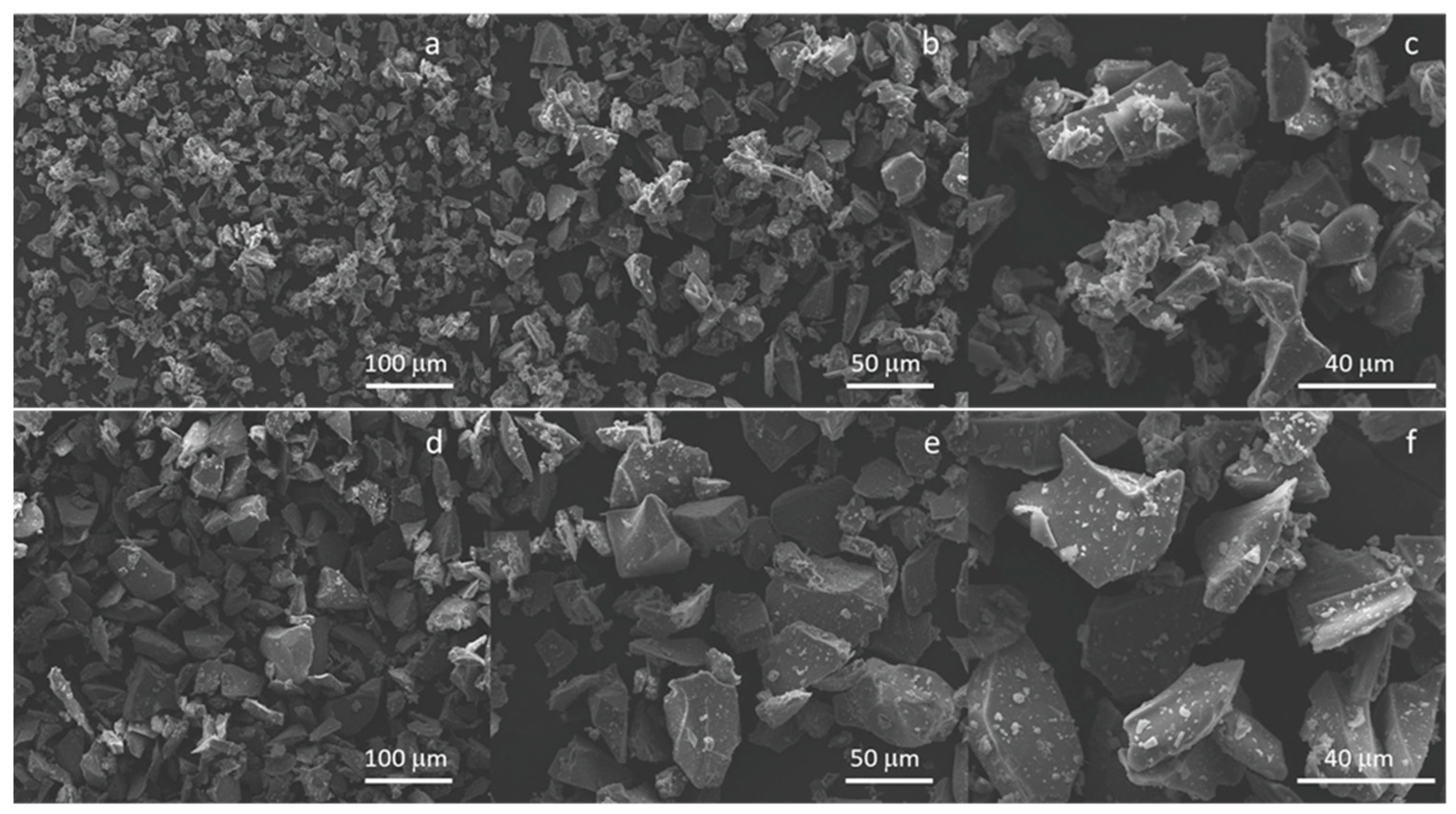


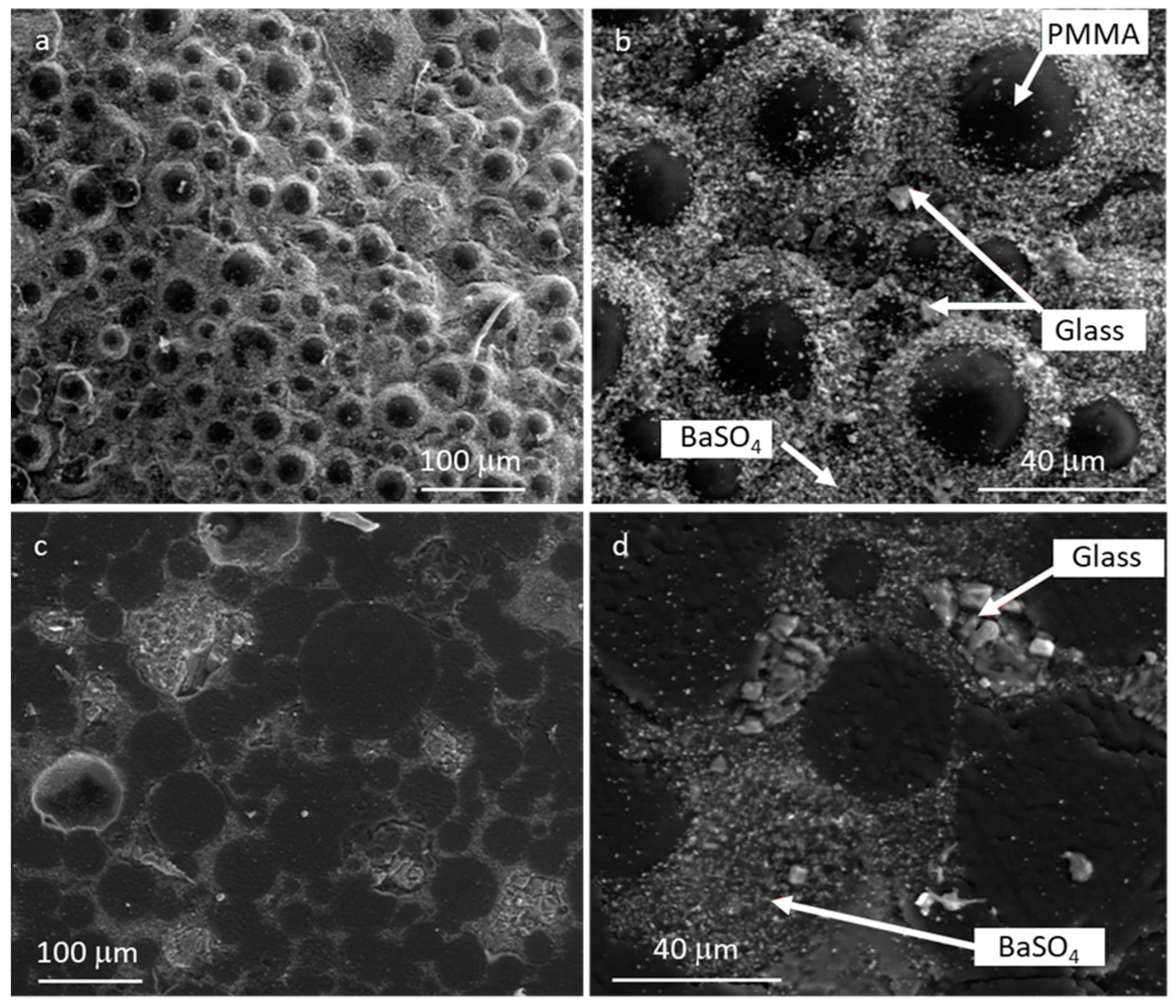
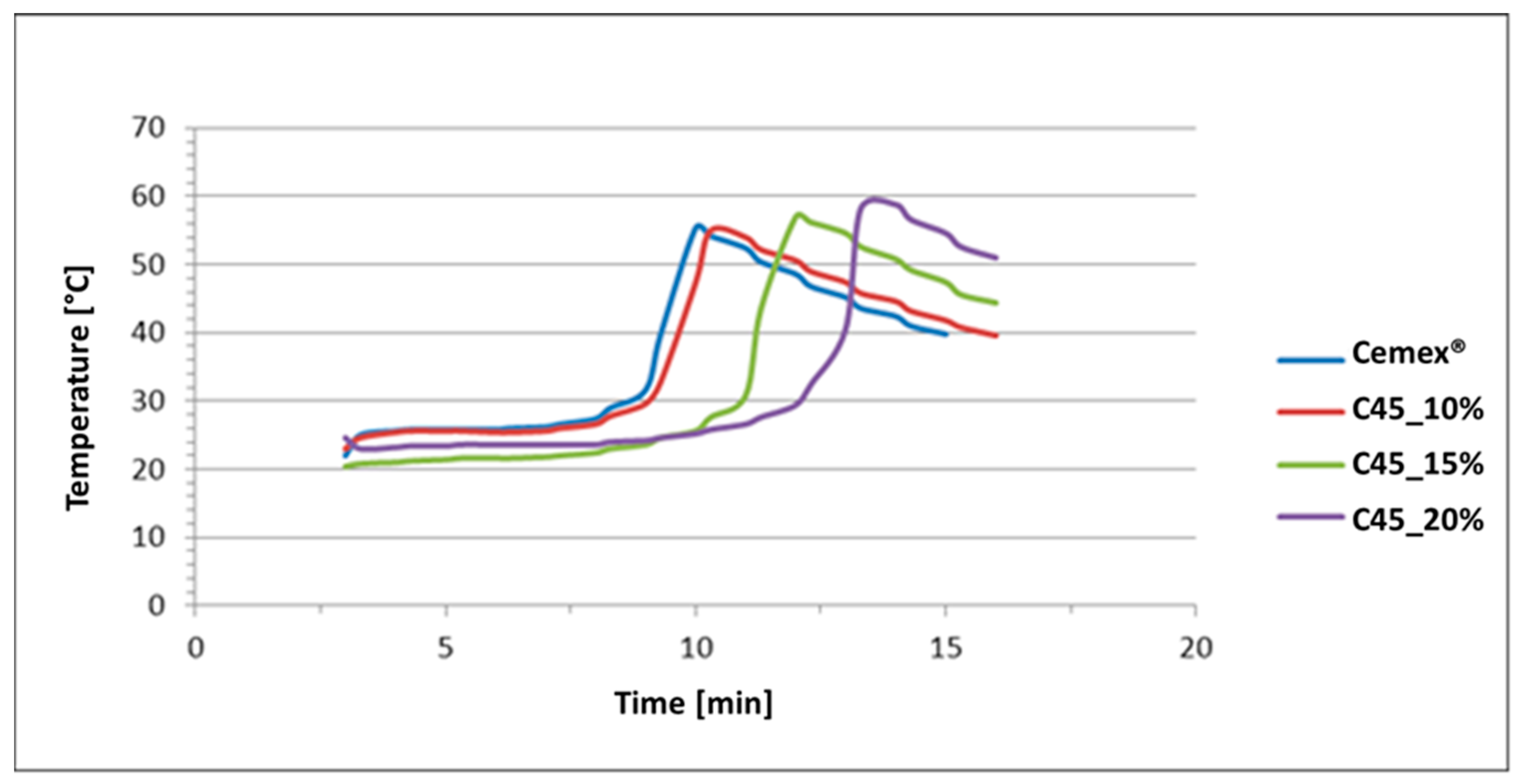
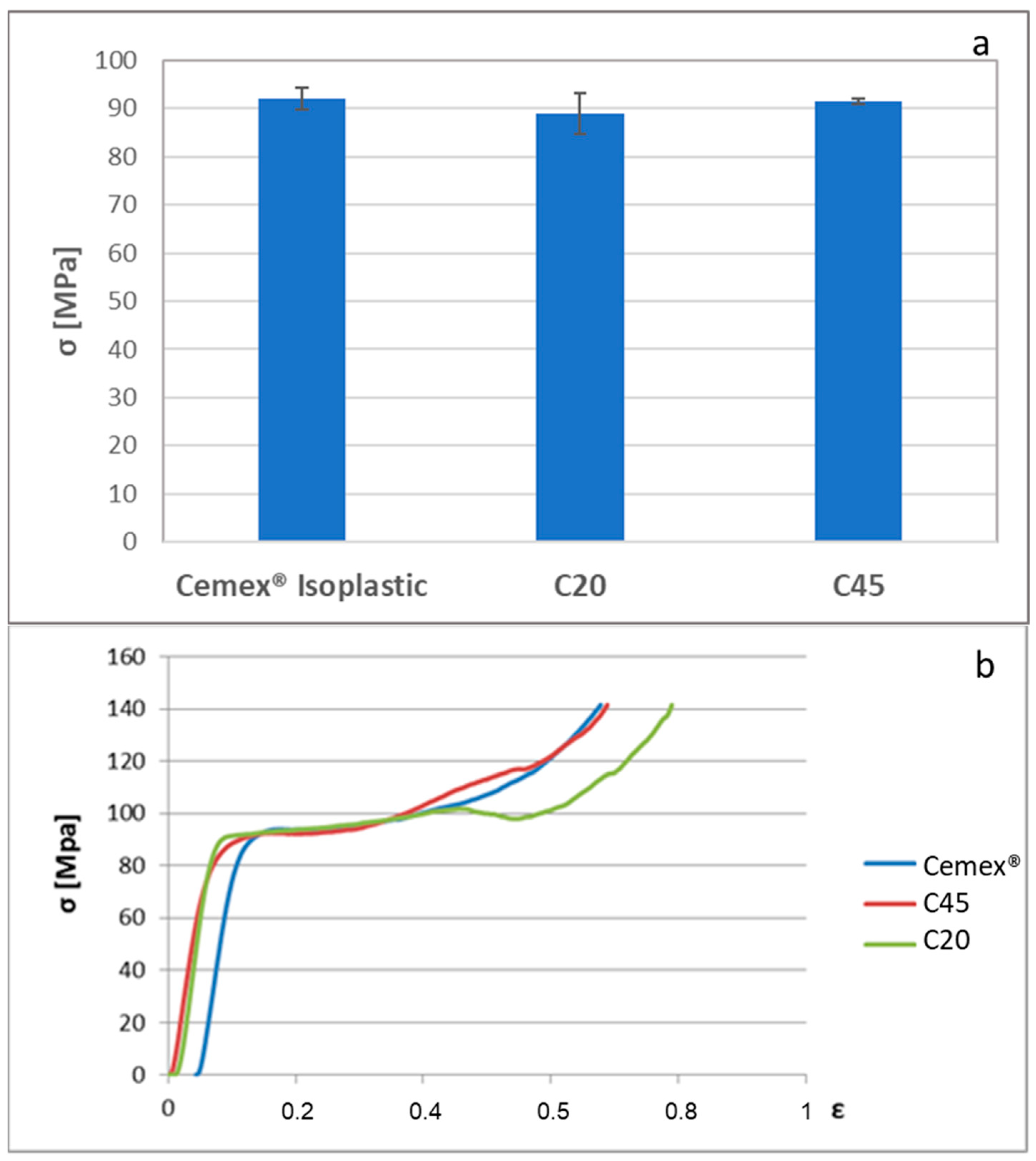


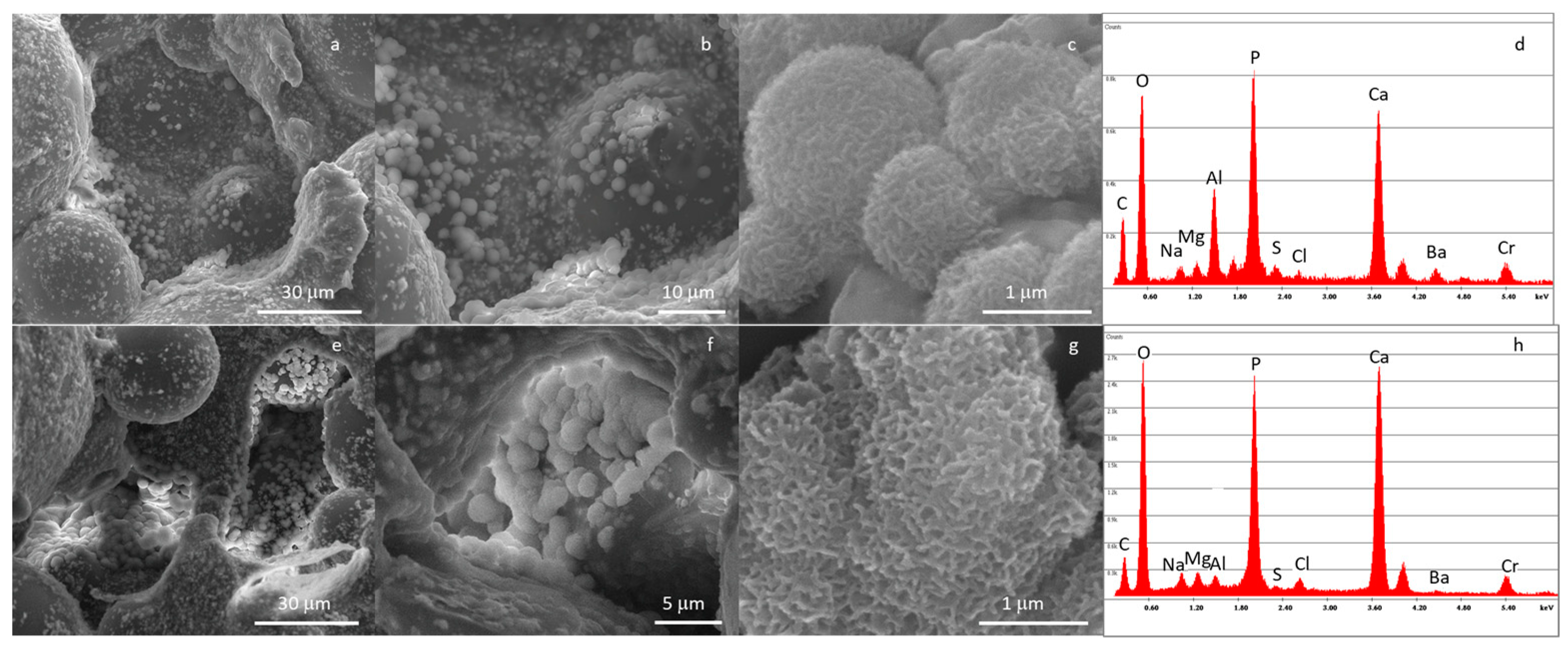


| Tmax (°C) | tmax (min) | Tset (°C) | tset (min) | |
|---|---|---|---|---|
| Cemex® Isoplastic | 58 | 9.3 | 40 | 8.3 |
| C45_10% | 51 | 10 | 37 | 9.3 |
| C45_15% | 57 | 12 | 39 | 11.3 |
| C45_20% | 59 | 12.3 | 40 | 12 |
Disclaimer/Publisher’s Note: The statements, opinions and data contained in all publications are solely those of the individual author(s) and contributor(s) and not of MDPI and/or the editor(s). MDPI and/or the editor(s) disclaim responsibility for any injury to people or property resulting from any ideas, methods, instructions or products referred to in the content. |
© 2023 by the authors. Licensee MDPI, Basel, Switzerland. This article is an open access article distributed under the terms and conditions of the Creative Commons Attribution (CC BY) license (https://creativecommons.org/licenses/by/4.0/).
Share and Cite
Miola, M.; Lucchetta, G.; Verné, E. Physical, Mechanical, and Biological Properties of PMMA-Based Composite Bone Cement Containing Silver-Doped Bioactive and Antibacterial Glass Particles with Different Particles Sizes. Materials 2023, 16, 4499. https://doi.org/10.3390/ma16134499
Miola M, Lucchetta G, Verné E. Physical, Mechanical, and Biological Properties of PMMA-Based Composite Bone Cement Containing Silver-Doped Bioactive and Antibacterial Glass Particles with Different Particles Sizes. Materials. 2023; 16(13):4499. https://doi.org/10.3390/ma16134499
Chicago/Turabian StyleMiola, Marta, Giovanni Lucchetta, and Enrica Verné. 2023. "Physical, Mechanical, and Biological Properties of PMMA-Based Composite Bone Cement Containing Silver-Doped Bioactive and Antibacterial Glass Particles with Different Particles Sizes" Materials 16, no. 13: 4499. https://doi.org/10.3390/ma16134499
APA StyleMiola, M., Lucchetta, G., & Verné, E. (2023). Physical, Mechanical, and Biological Properties of PMMA-Based Composite Bone Cement Containing Silver-Doped Bioactive and Antibacterial Glass Particles with Different Particles Sizes. Materials, 16(13), 4499. https://doi.org/10.3390/ma16134499







